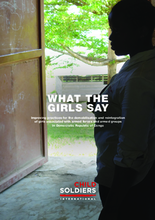Introduction
This report presents the findings of research conducted by Child Soldiers International to assess the effectiveness of release, psychosocial recovery and reintegration interventions (commonly referred to as ‘DDR’) for girls associated with armed groups in eastern Democratic Republic of Congo (DRC). More specifically, it seeks to shed some light on the extent to which girls have been reached by DDR programmes, and on the appropriateness of this support where it was offered, mostly from the point of view of the girls themselves.
It is important to note that the objective of the report is not to provide an overall assessment of all DDR programmes for girls in eastern DRC, but to convey the perspective of girls formerly associated with armed groups in exploring and exposing some of the reasons why many are still not receiving appropriate assistance.
Child Soldiers International developed the framework for the research, using information gathered over 10 years of research and advocacy work in DRC; recommendations made by the Committee on the Rights of the Child to the DRC government in February 2012; and extensive consultations with Congolese non-governmental organisations (NGOs).
Our research team spent six weeks in South Kivu, North Kivu and HautUélé provinces in January-February 2016 and interviewed: 150 girls formerly associated with armed groups; 89 members of communitybased child protection networks (known as “RECOPE”); 12 teachers and school principals; 8 religious leaders; 14 local authority officials; and 46 DDR actors (see Annex II).
In October 2016, Child Soldiers International coordinated a postresearch workshop for DDR providers in eastern DRC, including those who participated in the study. The objective of the workshop, held in Goma (North Kivu), was to present the research findings and discuss practical steps to improve DDR assistance based on what we learned from the girls. Participants unanimously agreed that Child Soldiers International should develop a Practical Guide designed to support the release and reintegration of girls associated with armed groups through concrete and mainly low-cost interventions at the community level. These interventions were shared and discussed by participants at the workshop and based on their joint experiences and good practices. We have since developed this guide (see Annex I).

